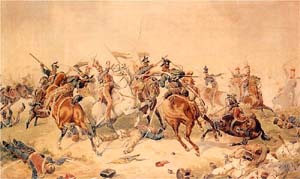The directory «Plots of stamps in the catalogue»
War with Fifth Coalition
1809

Still smarting from its earlier defeats at the hands of Napoleon Bonaparte, Austria was always keen to have another crack at the French. Army reforms gave its military confidence in being able to tackle the French army and it was just a matter of biding time until the opportunity arose. That chance came in April 1809 when Vienna, and its coalition partner Britain, decided to take advantage of Bonaparte's preoccupation with matters in the Peninsular War by striking at Bavaria, France's key ally in Germany. Archduke John led an Austrian army into Italy, brushing off Eugene de Beauharnais' forces at Sacie, while Archduke Charles fell upon the unsuspecting French who had been poorly placed by the out-of-his-depth Marshal Berthier. Caught completely on the back foot, the French were in dire trouble when help came in the form of the emperor himself. Bonaparte quickly united his soldiers and immediately threw them into an offensive against the strung out and confident Austrians. His lightning crossing of the Danube smashed into Charles' men at Abensberg and split the Austrians in two. Each wing of the retreating army fell back but were pursued vigourously by the French and two further battles, at Landshut and Eckmuhl, again ended in defeat for the Austrians. After capturing Ratisbon, Bonaparte moved into the enemy capital of Vienna eager to track down Charles' army and destroy it. Overconfident after the way the campaign had swung, Bonaparte decided to cross the flooding Danube at Aspern-Essling, but that cockiness and poor scouting sent a large portion of his force headlong into the entire Austrian army. The bridge connecting his forces continually was broken - by raging waters or objects sent down by the Austrians - and the vanguard was trapped. Fortunately, for Bonaparte, he had two top marshals in the forms of Jean Lannes and Andre Massena leading the isolated men, who soon established solid defensive positions in the villages of Aspern and Essling. The trick was, however, to get them back across the river. Bonaparte achieved it after two days of hard fighting but lost his friend Lannes, an irreplaceable marshal, and some 21,000 men. The Austrians suffered 23,000 casualties but had put a large dent in the myth of Bonaparte's invincibility. Suitably chastened, the French emperor ensured his next crossing of the Danube was carried with proper care and he fell upon the Austrians at Wagram. In two days, he inflicted 40,000 casualties upon his enemies and forced Austria to sue for peace, agreeing to give up large territories and join the Continental System of trade against Britain.
Ajman, 1971, Napoleon
Austria, 2002, Thayatal National park in Wagram
Austria, 2009, Archduke Charles during the Battle of Aspern
Chad, 1969, The Battle of Wagram
Chad, 2001, Napoleon Bonaparte
Equatorial Guinea, 1977, Napoleon on Horseback
Equatorial Guinea, 1977, Battle of Wagram
Fujeira, 1972, Napoleon I
Israel, 2009, Berek Joselewicz
Manama, 1970, Napoleon at Ratisbon
Manama, 1972, Return to Lobau
Mozambique, 2009, Napoleon, Route of Napoleon
Paraguay, 1971, Napoleon on Horseback
Poland, 2009, Berek Joselewicz
Ras al-Khaima, 1970, Napoleon after the Battle of Aspern
YAR, 1969, Napoleon on Horseback
YAR, 1969, Napoleon on Horseback
Austria, 2009.06.04,  Vienna. Archduke Charles
Vienna. Archduke Charles
France,  Paris, post office Wagram
Paris, post office Wagram
Italy, 2009.05.03,  Porcia. Bicentenary of Camolli Battle
Porcia. Bicentenary of Camolli Battle